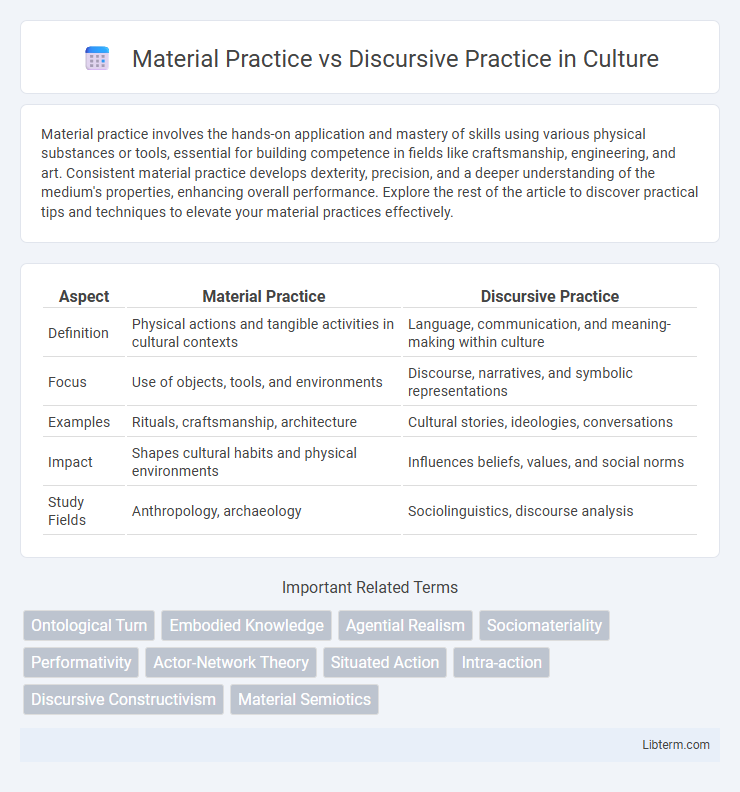Material practice involves the hands-on application and mastery of skills using various physical substances or tools, essential for building competence in fields like craftsmanship, engineering, and art. Consistent material practice develops dexterity, precision, and a deeper understanding of the medium's properties, enhancing overall performance. Explore the rest of the article to discover practical tips and techniques to elevate your material practices effectively.
Table of Comparison
| Aspect | Material Practice | Discursive Practice |
|---|---|---|
| Definition | Physical actions and tangible activities in cultural contexts | Language, communication, and meaning-making within culture |
| Focus | Use of objects, tools, and environments | Discourse, narratives, and symbolic representations |
| Examples | Rituals, craftsmanship, architecture | Cultural stories, ideologies, conversations |
| Impact | Shapes cultural habits and physical environments | Influences beliefs, values, and social norms |
| Study Fields | Anthropology, archaeology | Sociolinguistics, discourse analysis |
Introduction to Material and Discursive Practices
Material practices involve tangible interactions with physical objects and environments, emphasizing how tools and artifacts shape human behavior and social patterns. Discursive practices refer to the use of language, communication, and symbolic systems in constructing meaning and social realities. Both frameworks are essential for understanding the interplay between concrete actions and abstract meanings in social theory.
Defining Material Practice
Material practice involves the tangible, physical actions and interactions within a specific context, including the use of tools, objects, and spaces that shape human behavior and social structures. It encompasses the bodily movements, sensory experiences, and the manipulation of physical materials that contribute to the creation and maintenance of social reality. This concept is central to understanding how material conditions influence cultural and social practices independently of language or discourse.
Understanding Discursive Practice
Discursive practice involves the ways language is used to construct meaning, shape identities, and influence social realities through communication and representation. It encompasses the interpretation of texts, conversations, and symbols within cultural and social contexts, highlighting how power relations and ideologies are embedded in discourse. Understanding discursive practice requires analyzing how language functions not only to convey information but also to produce social effects and maintain or challenge societal norms.
Historical Context of Material vs Discursive Approaches
Material practice and discursive practice represent two distinct paradigms deeply rooted in intellectual history. Material practice emphasizes tangible actions and physical interactions, tracing back to Marxist theory's focus on labor and production as drivers of social change. Discursive practice emerges from post-structuralist thought, highlighting language, power relations, and social constructs as fundamental to understanding human behavior and societal structures.
Theoretical Foundations: Key Thinkers and Concepts
Material practice and discursive practice are grounded in the theoretical frameworks of social constructivism and post-structuralism, with key thinkers like Michel Foucault emphasizing the power dynamics embedded in discourses and Pierre Bourdieu highlighting the role of habitus in shaping material practices. Foucault's concept of discourse examines how language and knowledge systems regulate social institutions, while Bourdieu's theory bridges material and discursive practices through the interplay of objective structures and subjective dispositions. These foundational theories underscore the reciprocal relationship between tangible actions and the symbolic frameworks that inform social behavior and identity formation.
Intersections and Divergences between Material and Discursive Practices
Material practices involve tangible actions and physical interactions with objects, shaping social realities through embodied experience. Discursive practices center on language, communication, and meaning-making, influencing perceptions and social structures through narrative and discourse. The intersection occurs as materiality grounds discourse in concrete experiences, while divergence arises from discursive practices' abstract, symbolic nature that can reinterpret or challenge material realities.
Case Studies: Material Practice in Action
Material practice encompasses tangible actions and the physical manipulation of objects within real-world settings, as demonstrated in case studies analyzing construction site workflows. Discursive practice involves the use of language, communication, and symbolic meanings to shape understanding, often examined through interviews and textual analysis in organizational scenarios. Case studies of material practice reveal how hands-on engagement with tools and environments directly influences project outcomes and the enactment of social norms.
Case Studies: Discursive Practice in Action
Case studies of discursive practice reveal how language shapes social realities and power relations within specific contexts, emphasizing the role of discourse in constructing identities and institutional norms. Analyzing courtroom interactions, media narratives, or organizational communications demonstrates how discursive practices influence perception, decision-making, and behavior. These studies highlight the dynamic interplay between language and social structures, contrasting with material practice's focus on physical actions and artifacts.
Implications for Research and Methodology
Material practice emphasizes tangible interactions with physical objects and environments, influencing research methods to prioritize ethnographic observation, sensory data collection, and embodied experience analysis. Discursive practice centers on language use, communication patterns, and meaning-making processes, guiding qualitative methodologies like discourse analysis, narrative inquiry, and critical textual interpretation. Understanding the interplay between materiality and discourse enriches methodological frameworks, encouraging hybrid approaches that capture both embodied actions and communicative constructs for comprehensive social analysis.
Conclusion: Integrating Material and Discursive Perspectives
Integrating material and discursive practices reveals how physical artifacts and social meanings co-construct realities, emphasizing the inseparability of tangible actions and language in shaping human experience. This holistic approach enhances understanding of how power, identity, and knowledge are negotiated through both embodied interactions and communicative processes. By bridging these perspectives, scholars can more effectively analyze complex social phenomena where materiality and discourse are intertwined.
Material Practice Infographic

 libterm.com
libterm.com